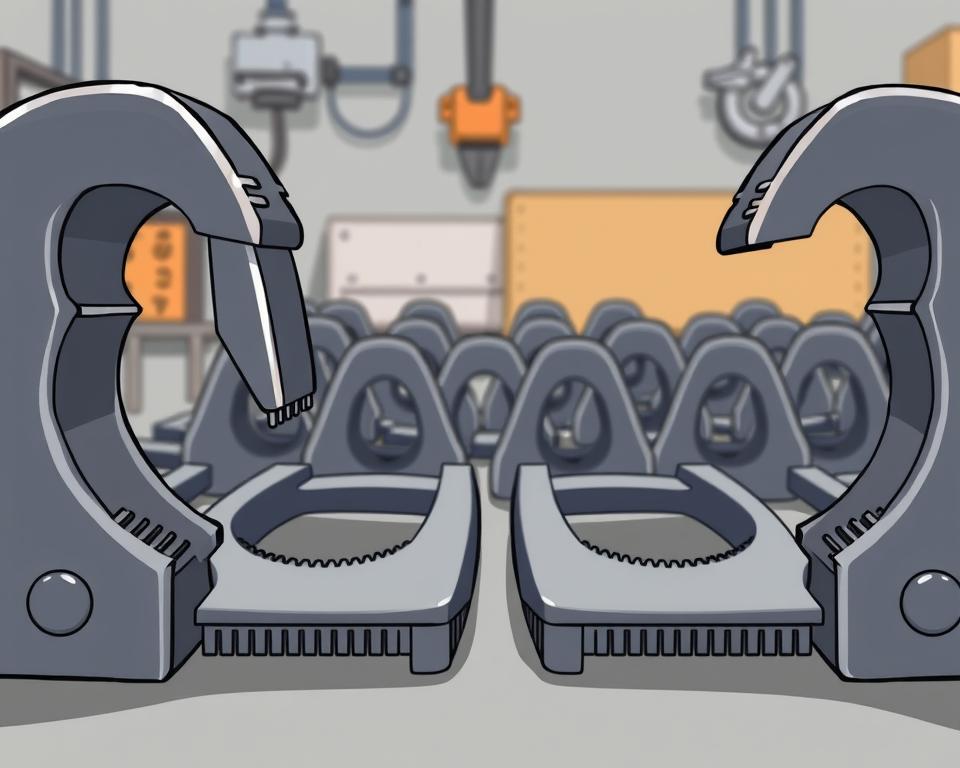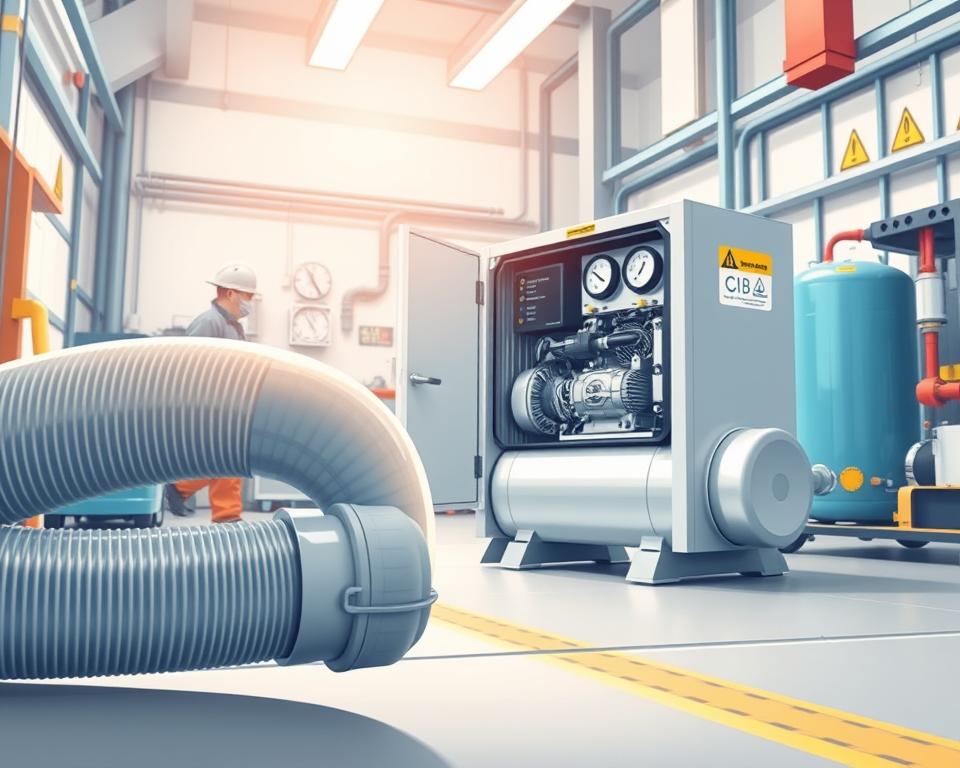Chromium Oxide Green Applications in Refractories Discussed.
Are you aware that approximately 80% of the world’s chromium production is used for producing refractories? Chromium oxide green, scientifically referred to as Cr2O3, is a standout for its distinct characteristics. These properties render it key in thermal uses. It enhances strength and oxidation resistance in numerous industries.
This discussion will explore the extensive uses of chromium trioxide in refractory materials. We will highlight its role in modern industry. Let’s discover why this versatile material is so essential.
Overview of Green Chromium Oxide
Green chromium oxide is a rich green powder recognized for its multi-use potential and durability. It is important in the sector of refractories thanks to its unique properties. This compound doesn’t just boosting the visual appeal of products, but also provides substantial practical advantages for challenging industrial uses.
In the refractory industry, green chromium oxide is essential. It enhances the high-temperature resistance and toughness of materials in extreme environments. This covers uses in steel manufacturing and glass production. As companies progress, the material’s importance grows, offering solutions for extreme heat applications where reliability is vital.
Green chromium oxide is not only a colorant; it’s a vital component for reliable commercial uses. Its versatility and resilience render it a necessary component in the creation of reliable refractory products.
Grasping Chromium Oxide and its Composition
Chromium oxide, also referred to Cr2O3, is a substance composed of chromium and oxygen atoms. Its makeup of chromium oxide exhibits special characteristics that enhance its application in multiple fields. This compound’s chemical structure is strong and stable, delivering durability in harsh conditions.
The heat-resistant traits of green chromium oxide are exceptional in uses demanding substances that tolerate extreme heat. It demonstrates a strong capacity to endure temperature fluctuations. This makes it perfect for metalworking and other industrial processes where heat is crucial.
Grasping the complexities of the makeup of chromium oxide helps industries leverage its built-in strengths. Its ability to endure pressure boosts overall effectiveness. This places green chromium oxide as a top choice among thermal-resistant substances.
Significance of Chromium Trioxide in Refractories
Trioxide of chromium is vital for the performance of refractories due to its unique properties. It boosts the reliability and durability of these materials in harsh environments. This insight is crucial for appreciating its function alongside chromium oxide in various applications.
Function of Chromium Trioxide in Enhancing Stability
Refractory materials are required to endure extreme heat without breaking down. Chromium trioxide boosts their heat tolerance and internal strength. This results in less damage, rendering it key for companies needing reliable substances.
Comparison of Green Chromium Oxide and Chromium Trioxide
Chromium oxide and trioxide of chromium have different functions in refractory materials. Both are crucial, but are not the same in their features:
| Characteristic | Chromium Oxide | Trioxide of Chromium |
|---|---|---|
| Stability | Reliable heat resistance | Superior heat tolerance |
| Area of Use | Frequently applied in refractories | Optimal for intense thermal scenarios |
| Strength | Average strength | Notably enhances strength |
This analysis shows the specific strengths of green chromium oxide and trioxide of chromium to heat-resistant compounds. Their distinct properties improve efficiency and lifespan in various industrial settings.
Thermal Endurance Features of Green Chromium Oxide
Chromium oxide green exhibits noteworthy characteristics, rendering it ideal for thermal uses. Its temperature threshold can soar to very high heat levels, ensuring exceptional reliability in extreme conditions. This is crucial for sectors needing resilience, especially in metalworking industries.
Fusion Temperature and Build Quality
Green chromium oxide is renowned for its high-temperature fusion point, vital for keeping the durability of refractories. This thermal endurance allows it to tolerate extreme heat without deforming. Its ability to resist melting renders it vital in applications where reliability is crucial.
Uses in Metalworking
In metalworking, chromium oxide green’s ability to withstand heat is vital. It’s often applied in thermal-resistant building blocks for furnaces and ovens. These blocks endure harsh heat and need to maintain integrity. Chromium oxide green’s thermal endurance makes them effective, boosting performance in metalworking.
Advantages of Green Chromium Oxide in Refractories
Green chromium oxide greatly boosts refractory compounds, vital for multiple sectors. It improves physical traits and resistance to oxidation. These enhancements boost the durability and performance of refractories.
Boosting Physical Strength
Incorporating chromium oxide into refractories notably boosts their structural qualities. Important gains involve:
- Increased hardness: Chromium oxide green’s toughness boosts the longevity of substances against wear.
- Improved durability: Its makeup lowers the impact of usage from constant wear, lengthening the lifespan of materials.
- Enhanced structural resilience: This property allows refractories to resist physical pressure, making it ideal for exacting uses.
Resistance to Oxidation in Heat-Intensive Uses
Green chromium oxide’s resistance to oxidizing conditions is essential in heat-intensive applications. The gains are:
- Extended longevity: Refractories resist degradation, surviving intense heat.
- Enhanced operational efficiency: They experience less material loss, allowing for consistent performance in sectors.
- Minimized replacement needs: Less frequent replacement of materials reduces expenses for industries relying on heat-resistant materials.
These chromium oxide green advantages boost refractory performance and promote eco-friendliness. They prolong product use and lessen material waste.
Understanding the Uses of Chromium Oxide Green in Refractories
Green chromium oxide has proven vital in a range of sectors due to its exceptional features. It performs well in various sectors, from metal manufacturing to ceramics manufacturing. Its importance as a key ingredient in thermal-resistant products underscores its significance.
Sectors Utilizing Chromium Oxide Green
Chromium oxide green is crucial in several sectors for enhanced functionality. Here are the main industries and their specific uses:
- Iron and Steel Production: It’s used in manufacturing refractory components and thermal-resistant castables, offering temperature durability and resistance to wear.
- Glassworks: In heat-resistant coatings, it ensures high temperatures and delivers chemical integrity.
- Ceramics Manufacturing: As a dye in ceramic finishes, it provides coloration, strength, and material strength.
- Cement Industry: It boosts the quality of heat-resistant compounds for intense thermal applications.
Wide Range of Refractory Material Applications
Green chromium oxide’s versatility goes beyond individual sectors. Its uses include a broad spectrum, including:
- Durable heat-resistant bricks
- Moldable refractory materials for harsh environments
- Furnace coatings to prevent corrosion
- Special ceramics needing thermal properties
This diverse field of applications proves chromium oxide green’s significance in improving manufacturing processes. Its unique qualities enable companies meet modern production demands, ensuring better performance and extended material life.
Primary Sectors for Green Chromium Oxide
Green chromium oxide is crucial in various industries, known for its adaptability and effectiveness. It is frequently utilized in the field of heat-resistant materials, boosting temperature durability and structural integrity. This compound is essential in substances created for harsh environments.
In the manufacture of thermal-resistant components and inner linings, chromium oxide green stands out. These materials are critical in intense thermal situations like furnaces, heat chambers, and burning devices. Incorporating green chromium oxide boosts their performance, ensuring they endure more and perform consistently.
- Ceramics: Green chromium oxide is key in pottery, improving color retention and material strength.
- Metal Production: It is applied in metallurgy for equipment and items needing high thermal resistance.
- Glass Manufacturing: In glassworks, green chromium oxide guarantees the longevity of melting tanks.
This substance is essential not just in traditional uses but also in modern materials. The trend for eco-friendly practices is driving its application in next-generation heat-resistant compounds.
As industries focus on performance and productivity, chromium oxide green remains essential. Its wide range of uses shows its importance across multiple fields. This confirms its value in the current heat-resistant material market.
Green Chromium Oxide Manufacturing Processes
The manufacture of chromium oxide green uses several proven methods, each with unique advantages and challenges. These approaches are vital for creating pure green chromium oxide, vital for its wide-ranging applications. Methods such as burning, water-based, and settling are key in production and quality control.
Common Preparation Methods
Many typical production techniques are utilized in chromium oxide green manufacture. These include:
- Combustion Method: This process consists of the burning of chromium compounds with carbon-based substances. It is productive and has a reduced impact on the environment.
- Hydrothermal Method: This process uses the interaction of chromium oxides in an water-based mixture under intense pressure and temperature. It produces high-purity products.
- Solid Formation Process: This process involves the solid formation of chromium oxides from water-based suspensions. It allows for control over particle size and shape.
Each technique has specific pros, such as affordability and scalability, but also has drawbacks like refinement and particle size variations. Picking the best technique greatly affects the final product’s properties and its effectiveness for specific applications.
Maintaining Standards in Chromium Oxide Green Production
Maintaining standards is vital in the creation of chromium oxide green. It ensures the final product complies with regulations for purity and consistency. Important areas of quality control consist of:
- Frequent evaluation of base substances to maintain material quality for green chromium oxide production.
- Oversight of process variables, such as heat and force, during the multiple production processes.
- Produced material evaluation for structure and physical properties, guaranteeing adherence with target characteristics.
Good production oversight methods enhance the consistency and performance of chromium oxide green for its wide-ranging roles. This highlights the significance of these production techniques in the entire production chain.
Sustainable Methods for Producing Chromium Oxide Green
The trend toward eco-friendliness is reshaping the production of chromium oxide green. Eco-conscious efforts is now a major priority as producers look for ways to reduce emissions. By embracing eco-friendly methods, they reduce emissions and conserve materials.
Integrating sustainability into the manufacturing of green chromium oxide fulfills regulatory requirements and consumer demands. Companies are now more conscious of their eco-footprint. By using advanced processes, they enjoy benefits such as:
- Using waste materials in production, which cuts down on the need for new resources.
- Boosting energy efficiency in creating products.
- Enhancing recycling practices to lessen damage to the environment.
The eco-friendly application of green chromium oxide is also clear in various sectors. For instance, it plays a key role in exhaust gas treatment systems, reducing toxic output. This proves the importance of eco-conscious practices in the field of refractories.
| Method | Description | Environmental Benefit |
|---|---|---|
| Material Use | Using recycled materials for production | Lowers need for new resources |
| Energy Efficiency | Techniques to lower energy consumption | Reduces energy-related emissions |
| Emission Reduction | Using emission-lowering devices | Minimizes environmental contamination |
| Waste Minimization | Efficiently reusing by-products | Decreases environmental contamination |
As companies emphasize green initiatives, chromium oxide green production and application become crucial. They show how eco-conscious methods and technological advances can work together, paving the way for a greener future.
Future Innovations in Chromium Oxide Green Use
The domain of refractory applications is poised for major changes, especially with the advancements in green chromium oxide. As sectors focus on sustainability, the next phase of this material gains importance.
Emerging technologies are driving innovation in the use of green chromium oxide, such as:
- Better temperature endurance for enhanced functionality in challenging settings.
- Innovative blends that broaden its application in metalworking and ceramics.
- Innovative manufacturing techniques to lower emissions while maintaining quality.
The incorporation of green chromium oxide into next-generation refractories promises effective solutions for sectors worldwide. Relentless R&D is set to leverage this material’s unique properties. This guarantees it remains crucial in cutting-edge refractory technology.
By adopting these innovations, industries can improve the effectiveness and eco-friendliness of their thermal-resistant solutions. This makes the future of green chromium oxide very promising.
Final Thoughts
Chromium oxide green is a key compound that enhances the durability and efficiency of refractory products across diverse industrial sectors. Its exceptional properties, such as heat endurance and oxidation resistance, are important for steel production and ceramics industries.
The exploration of chromium oxide green’s applications highlights its versatility and importance in modern manufacturing. Continued advancements in manufacture expand its possibilities, promising it continues to be essential for reliable applications.
As the trend toward eco-friendly production expands, chromium oxide green’s role is set to increase. Its use in creating sustainable refractory materials underscores its essential part in the modern refractory industry. This promises increased efficiency and productivity in a rapidly evolving industrial setting.



